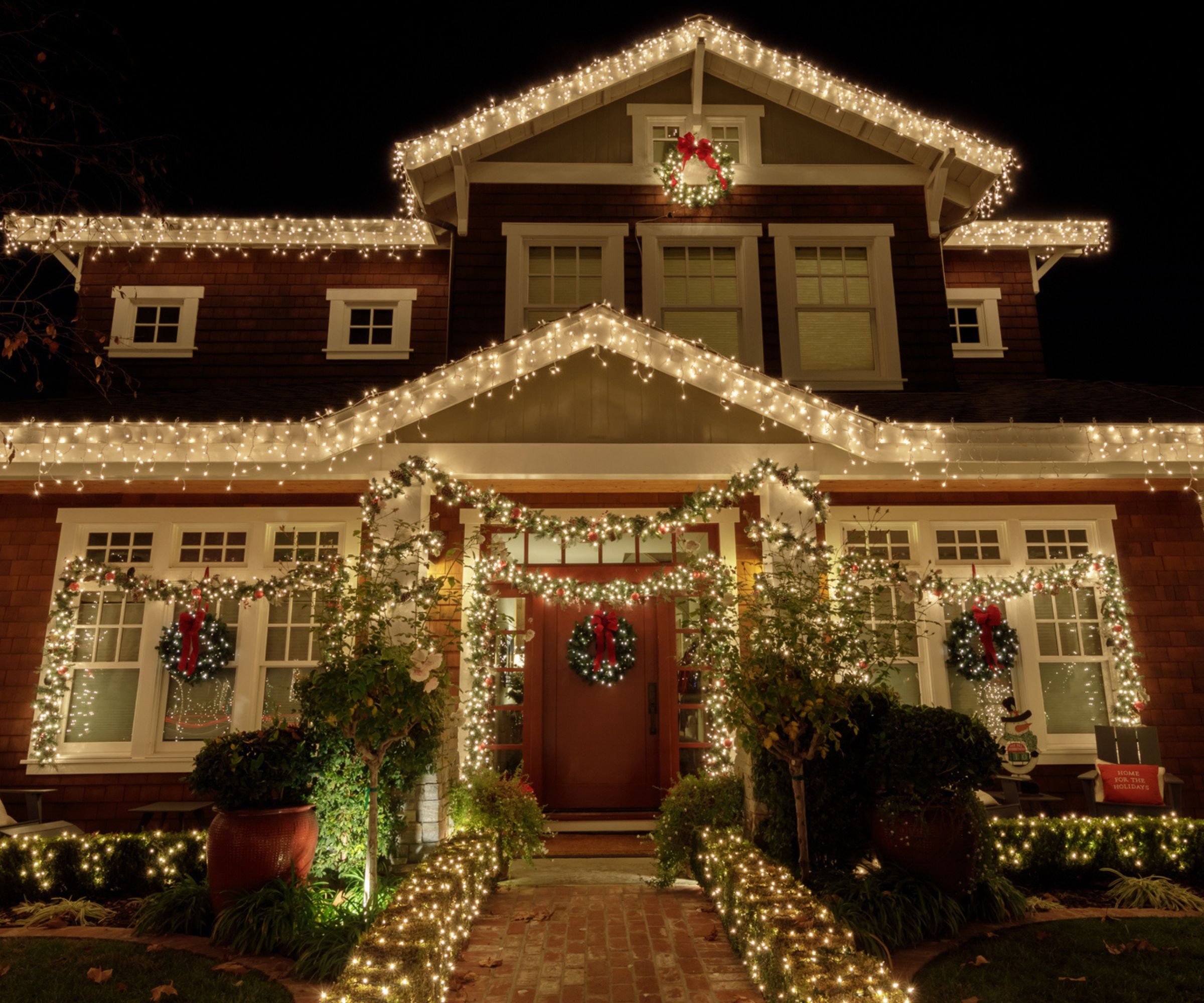
There's almost nothing as festive as Christmas lights. Decorating the exterior of your home with twinkling lights is the perfect way to welcome guests and make the whole neighborhood feel cozy.
But outdoor Christmas light colors can be hard to get right. Too white and they look stark; too gold and they look gaudy. They can also be controversial, with some people loving the retro throwback of multicolored 90s Christmas lights, while others think it looks tacky.
I spoke to design experts - including a designer who specializes in Christmas decor - about the best colors to use for your outdoor Christmas lights. They revealed the pros and cons of a range of different lights, and finally settled the debate as to whether or not it's ever acceptable to use those contentious multicolored lights.
1. White lights for sophistication

White lights are a Christmas staple, and they work for almost any home. Whether you have an old colonial home, a sleek modern condo, or a standard suburban house, white lights are a reliable favorite.
Professional Christmas designer Patricia Derpinski told me that 'White lights are a classic for a reason - they’re elegant, luxurious, versatile, and timeless. Far from being too formal, they can suit almost any style, whether you’re going for something cozy and traditional or sleek and modern.'
The only potential issue with white lights is that they can be too intense. Bright white light can be too similar to office lighting, creating stark lighting across your home. However, this is easy to avoid.
Professional lighting designer Anna Tatsioni advises 'Pure white LEDs create a crisp, sophisticated wash that highlights architectural details. Warm white (2700K-3000K) adds a softer, more inviting glow that feels less sterile.'
These Christmas lights are incredibly good value, offering 328 feet of lights, with 1000 LEDs. Not only do they shine bright white, but you can turn the brightness up and down as you need.
Icicle lights like these are the perfect way to bring in white lighting without resorting to the obvious and draping the lights in a tree. This set has strands of white light perfect for decorating a porch.
Micro fairy lights like these are great for subtle white lighting. The LEDs are buried in the wire itself, creating tiny, twinkling points of light rather than large, obvious lightbulbs.
2. Gold lights for cozniness

Gold is another classic, and perfect for elevating the outside of your home. The experts say that gold lighting brings coziness in the cold months, making the exterior of your home feel inviting.
Lighting professional Anna Tatsioni says 'I've used gold accent lighting in projects from modern minimalist homes to traditional estates. They add warmth and richness, especially when paired strategically.'
The only issue with gold lights is that it's easy to overdo it. Too much gold lighting casts a yellow tinge over your house, and it can be tacky if you use too much gold.
Patricia Derpinski adds 'Gold lights are another beautiful option. They have an elegant richness and warmth that feels luxurious, but gold can easily become overwhelming if overused.'
However, Patricia says there's an easy way to keep gold lighting understated. 'Pair gold lights with natural elements like lush greenery or neutral tones to create depth and avoid a look that feels overly flashy and gaudy.'
These are classic gold Christmas lights - 100 lights spread across 18 feet, UL-certified, and perfect for hanging along eaves or in trees.
To save a little money, you need these golden lights. They're 66ft long, and discounted for Black Friday.
Net lights like these are perfect for quick Christmas lighting. Rather than the hassle of weaving lights in between the branches of trees, you can just toss these net lights over a low shrub or hedge to cover the whole plant in golden light.
3. Red lights for festiveness

More controversially, red lights can be a smart choice for the festive season, but you should be careful. Too much red can be very intense; it gives more Halloween than holidays.
Anna Tatsioni says 'Red can absolutely work, but placement is key. Solid red feels heavy, but when integrated thoughtfully, like subtle red-trimmed white displays or interspersed red elements it creates vibrant energy without feeling oppressive.'
Another way to incorporate red lights is to play them off against other colors to tone down the intensity.
Patricia Derpinski says 'Red lights are a festive favorite, especially when used intentionally and thoughtfully. While they might feel a little intense on their own, pairing them with complementary colors—like green or warm white—can create a bold, cheerful atmosphere. Combined with green, white, or gold lights, red lights evoke that classic holiday charm we all love.'
These are classic red Christmas lights. This set has 100 bulbs so it should stretch a long way across your porch or around a tree. It's a particularly affordable set too - it only costs $5.
This mix of red, white and green lights is perfect for achieve the balance that Patricia recommends, softening the intensity of the red lights for gentler effective.
These little red lights from Menards are perfect for using some red lighting without completely overdoing it. They provide 1000 tiny points of red light that bring all the benefits outlined above but with subtlety that doesn't overwhelm your home.
4. Mix colors for tradition - but be careful

The most controversial Christmas lighting choice is multicolored lights. Lots of people adore this 1990s lighting aesthetic, but many people think it looks lurid and vulgar.
Architect and designer Matthew Coates is bullish on this topic. 'The mistake that most people make with outdoor Christmas decorations is using a big mixture of lights simply because that's what they have. I get it - lights are expensive and you might as well use what you have.'
However, other designers think that there can be a place for these lights. Patricia Derpinski says 'Multicolored lights are wonderfully nostalgic and cheerful. However, the key is to use them deliberately and strategically. Stick to one style of bulb or focus on a single area of the home to avoid a look that feels too cluttered and chaotic.
One of the best ways to achieve this look is to use incandescent lights rather than LEDs. Lots of people buy rainbow lights to evoke the Christmas lights they enjoyed as kids, but modern LEDs are often too harsh, so it's not quite the same. For the classic 90s effect, you need incandescent lights like these at Walmart. The drawback is that, compared to LEDs, these lights are much more fragile, have a shorter lifetime, and consume more power. If you want the effect, however, you need incandescent bulbs.
Anna Tatsioni agreed and told me that 'Multiple colors can work beautifully if thoughtfully coordinated. My rule? Choose a tight color palette. Maybe cool blues and whites for a winter wonderland, or warm golds and soft whites for a cozy feel. Random multi-color displays often look like a lighting department explosion.
In the end, the key is to keep your display understated and simple. While he doesn't recommend multicolored lights, Matthew says it can work if you keep lighting to a minimum. 'If you want to have a lighting display that rocks and seems thoughtful, it doesn't really matter what color or colors you choose, just pick a color palette and commit to it, says Matthew. 'Remember sometimes less is more.'
For simple, straightforward Christmas lights, this is all you need. It's not fancy, but this set offers 164 feet of multicolored lights, as well as lots of different lighting modes.
These high tech lights are perfect for more complicated displays. They can sync up to the rhythm of whatever song you're playing, and you can light each bulb exactly the color you want.
Permanent lights like these aren't just for Christmas. These Govee lights are easily controlled by an app, and because they have 75 inbuilt modes and RGBIC colors, you can tailor them to any event or season.
5. Play with patterns and colors

For the best of every world, choose color-changing lights with different flickering patterns. This gives you versatility, letting you change your lighting display from day to day or even hour to hour. You can use multicolored lights when you need a lift, gold lights to welcome guests, and cool white for sophistication.
Designer Anna Tatsioni says 'Smart LED systems allowing color changes are game-changers. My clients love programming dynamic displays, soft whites during elegant evening gatherings, and playful colors for family celebrations.'
Christmas decor expert Patricia Derpinski agrees, telling me that 'Lights that change and fade into different colors are always a fantastic option. They provide a nice variety and let you experiment with different looks and adapt to your mood throughout the season.'
As pretty as they are, there are a whole host of problems that can come with Christmas lights. Learning how to cut costs on running Christmas lights by using LEDs can help, as well as learning how to hang them securely, or how to fix them when they break.







